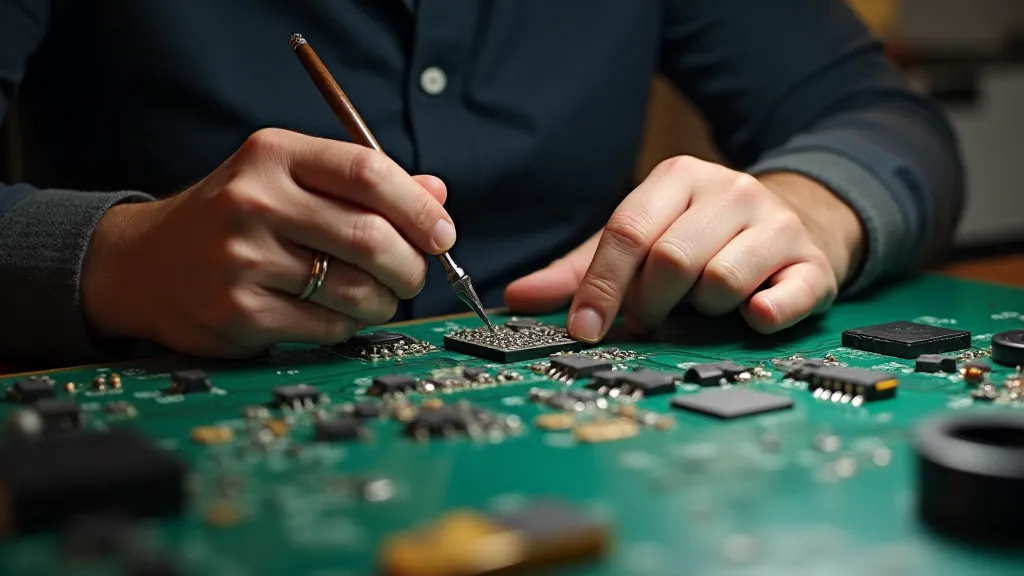Fractured Harmonies: Solving Interference and Noise in Radio Frequency Projects
There's a particular melancholy that clings to antique accordions. Holding one, feeling the weight of bellows and keys under your hands, you’d be connecting with a lineage of craftspeople – generations of meticulous engineers and skilled artisans who poured their expertise into creating instruments capable of transporting emotions. The sheer complexity, the hundreds of reeds vibrating in sympathetic resonance, all orchestrated by a surprisingly simple mechanical system… it's a beautiful thing. And, like any delicate mechanical system, vulnerable to disruption. Just as dust and age can silence an accordion’s voice, unwanted interference can ruin a radio frequency (RF) project. We’re going to explore how to identify and mitigate those disruptive forces, so your creations can sing clearly.
My first encounter with the havoc RF interference can wreak wasn't in a lab, but attempting to decode vintage radio transmissions. The clarity I expected, the promise of voices from the past – instead, a static blizzard of noise. It was frustrating, even disheartening. I’m a tinkerer at heart; I love to build, to create, to *hear* what I've made. That experience instilled in me a deep respect for the challenges inherent in working with RF signals, and it sparked a lifelong pursuit of cleaner, more reliable transmissions. It often feels like you've unearthed a hidden truth only to have it obscured by static—a sensation that is surprisingly common in many electronics endeavors, mirroring the meticulous fabrication process that goes into creating custom PCBs—a subject that’s more involved than one might initially assume, as explored in The Alchemist's Toolkit: Custom PCBs & the Art of Circuit Fabrication.

Understanding the Enemy: Sources of Interference
Interference in RF projects isn't some malevolent force; it’s simply unwanted energy bleeding into your circuit. Where does this energy come from? It’s far more pervasive than you might think. Consider these common culprits:
- Natural Sources: Atmospheric noise (lightning, solar flares), cosmic background radiation. These are largely unavoidable, but understanding their characteristics can inform your design.
- Electrical Devices: Switch-mode power supplies (SMPS), fluorescent lights, computers, even some LED lighting can emit significant RF noise. The harmonics produced by these devices can stray far from their intended frequency.
- Other Radio Transmitters: Cell phones, Wi-Fi routers, amateur radio operators – all emitting signals that could interfere.
- Poor Grounding: This is often the biggest culprit. A poorly grounded circuit is like an accordion’s reeds – they vibrate sympathetically with any nearby electrical disturbance.
- Improper Wiring: Long, unshielded wires act as antennas, picking up stray signals.
Just as a master accordion repairman meticulously diagnoses a failing reed, identifying the source of interference requires careful observation and methodical testing. A spectrum analyzer is an invaluable tool, allowing you to visualize the RF environment and pinpoint the frequencies where interference is occurring. Even a simple AM radio can be surprisingly effective as a basic RF detector – rotate the antenna and observe where the noise level changes; this will give you clues about the direction of the interfering signal. Troubleshooting these kinds of issues can feel like hunting for ghosts in the machine – a frustrating yet rewarding experience—particularly when the root cause is subtle and hidden, as documented in The Ghost in the Machine: Debugging the Unseen in Arduino Projects. The complex interplay of components in these systems, and the often-unpredictable behaviors that can arise from subtle design flaws, necessitate a systematic approach to minimizing interference. This is particularly relevant when transitioning from proof-of-concept prototypes, frequently built on breadboards, to production-ready circuits requiring optimized performance. Successfully managing interference becomes a crucial element in achieving those performance goals, and often demands techniques far beyond simple troubleshooting, requiring a deep understanding of circuit behavior and signal integrity. For anyone involved in designing circuits beyond simple experimentation, techniques like careful impedance matching and signal routing become paramount.
The Pillars of Interference Mitigation
Just as a well-maintained accordion relies on quality materials and precise construction, a robust RF project demands a strategic approach to interference mitigation. We can broadly categorize these strategies into four key areas: shielding, grounding, filtering, and antenna design.
Shielding: Creating a Fortress
Shielding involves physically blocking RF energy from entering or leaving a circuit. This is most often achieved with metal enclosures, but effective shielding goes beyond just a metal box. Consider these points:
- Complete Enclosure: Ensure the enclosure is completely sealed, with no gaps or cracks. Even small openings can compromise shielding effectiveness.
- Proper Contact: The enclosure needs to be electrically connected to the ground plane. Think of it as creating a closed loop – any stray RF energy entering the enclosure will be directed to ground.
- Shielded Cables: Use coaxial cables (coax) for connecting components that handle RF signals. Coax cables have a central conductor surrounded by a dielectric and then a grounded shield.

Beyond the immediate enclosure itself, a wider system-level approach is crucial for comprehensive shielding. The very layout of the circuit board, the routing of traces, and even the choice of component materials can all contribute to or detract from shielding effectiveness. Careful consideration must be given to minimizing discontinuities in ground planes and ensuring that all conductive surfaces are properly bonded. In cases involving wireless communication, ensuring that the enclosure effectively blocks unwanted signals from interfering with the intended transmissions becomes paramount. Often, achieving optimal shielding requires a combination of physical barriers and strategic component placement to create a resonant cavity that attenuates unwanted frequencies, much like a skilled instrument maker might carefully adjust the tension of an accordion's reeds to achieve a desired tonal quality. It's a multifaceted challenge demanding a holistic understanding of electromagnetic principles.
Grounding: Establishing a Reference
Grounding provides a stable reference point for voltage and a path for dissipating unwanted RF energy. It's arguably the *most* important aspect of RF circuit design. Poor grounding is the silent killer of many projects. Here’s how to approach it:
- Star Grounding: All ground connections should converge at a single point – the "star" – to minimize ground loops.
- Low-Impedance Ground Plane: A large, unbroken ground plane provides a low-impedance path to ground, reducing noise.
- Avoid Ground Loops: Ground loops occur when multiple ground paths exist, creating circulating currents that can introduce noise.
Effective grounding is far more complex than simply connecting a wire to a chassis. The overall design of the ground plane and its interaction with other components require careful consideration. Failing to do so can lead to unexpected behavior and a frustrating debugging experience—a common scenario when dealing with legacy hardware, often requiring meticulous emulation techniques, as demonstrated in Echoes in the Code: Preserving Legacy Hardware with Raspberry Pi Emulation. The principles of grounding are intimately linked to the performance of wireless systems. A poorly grounded circuit can act as an unintentional antenna, radiating noise and degrading the signal-to-noise ratio. Therefore, a robust grounding strategy isn't just about minimizing noise; it's about maximizing the efficiency and reliability of the entire communication system. Considering the broader system, it becomes clear that a robust grounding scheme is as crucial as the antenna itself, and its careful implementation can significantly impact the overall performance and stability of the device. The challenge lies in ensuring that the ground plane acts as a true shield, preventing unwanted signals from propagating through the circuit and interfering with the intended communication. This necessitates a holistic design approach that considers the electrical properties of all materials and components within the system.
Filtering: Fine-Tuning the Signal
Filtering is an essential technique for removing unwanted frequencies from a signal. Low-pass filters allow low-frequency signals to pass while attenuating high-frequency signals, while high-pass filters do the opposite. Band-pass filters allow a specific range of frequencies to pass, while rejecting others. The selection of the appropriate filter depends on the specific application and the nature of the interference. Careful design and implementation of filters can significantly reduce noise and improve the clarity of the signal, much like a skilled accordionist might use vibrato to shape the tone and expression of a performance.
Antenna Design: Radiating with Purpose
The antenna is the interface between the circuit and the electromagnetic environment. A poorly designed antenna can be a major source of interference, radiating noise and reducing the range and performance of the system. It’s vital that antenna design takes into account impedance matching and polarization to optimize signal transmission and reception. Efficient communication often requires innovative antenna designs capable of operating across multiple frequency bands, much like a modern accordion might incorporate digital effects and looping capabilities.
The challenges of RF interference are often amplified in complex systems relying on multiple sensors and actuators. These systems often require intricate signal processing algorithms to extract meaningful information from noisy data. Successfully managing interference becomes a crucial element in achieving those performance goals, and often demands techniques far beyond simple troubleshooting. A systems-level perspective, considering the entire communication chain from sensor to actuator, is essential for achieving optimal performance. This requires a deep understanding of circuit behavior and signal integrity, and a willingness to experiment with different design approaches. Moreover, the miniaturization trend in modern electronics presents unique challenges for antenna design and interference mitigation. Shrinking components while maintaining performance requires innovative solutions and a meticulous attention to detail. To achieve robust and reliable communication, a holistic approach that integrates design, fabrication, and testing is critical. For applications requiring long-range communication, strategies such as adaptive beamforming and spatial diversity become crucial tools. Understanding the underlying principles of signal propagation and interference is essential for designing systems that can operate effectively in challenging environments, and developing innovative solutions to overcome these challenges is an ongoing effort.
Ultimately, achieving clean and reliable RF communication is a multifaceted challenge requiring a deep understanding of electrical engineering principles and a willingness to experiment with different design approaches. The journey from a simple circuit to a sophisticated wireless system demands a holistic perspective that considers all aspects of the communication chain, from the antenna to the signal processing algorithms. For those seeking to expand their knowledge in this exciting field, resources such as the exploration of Raspberry Pi: Seeds of Automation – Cultivating Smart Home Ecosystems can provide valuable insights into the practical application of these principles in real-world projects.






